Page 25 of 621
15
2008 TUNDRA from Apr. ’08 Prod. (OM 34477U)
Driver ’s seat belt reminder light∗
1
Low engine oil pressure warning light∗1
Brake system warning light∗1
Charging system warning light∗1
Malfunction indicator lamp∗1
Anti −lock brake system warning light∗
1
SRS warning light∗1
or
Front passenger ’s seat belt reminder light∗1
Passenger airbag on −off indicator light
Engine oil replacement reminder light∗
1
(for vehicles sold in U.S.A.)
Open door warning light∗ 1
Tire pressure warning light∗1
Automatic transmission fluid temperature
warning light∗1
Engine immobilizer/theft deterrent system
indicator lightLow fuel level warning light∗1
Master warning light∗1
Low windshield washer fluid level warning light∗1
or
Indicator symbols on the instrument panel
Page 39 of 621
29
2008 TUNDRA from Apr. ’08 Prod. (OM 34477U)
�Unlock the driver’s door or front pas-
senger ’s door with the inside lock
knob, and then unlock all the doors
with the power door lock switch.
XS12007
REAR DOOR CHILD�PROTECTORS
(Double cab and Crew Max models)
Move the lock lever to the “LOCK”
position as shown on the label.
When the child−protector is locked, you
cannot open the rear door by the inside
door handle. We recommend using this
feature whenever small children are in the
vehicle.
CAUTION
Before driving, be sure that the doors
are closed and locked, especially
when small children are in the ve-
hicle. Along with the proper use of
seat belts, locking the doors helps
prevent the driver and passengers
from being thrown out from the ve-
hicle in an accident. It also helps pre-
vent the doors from being opened
unintentionally.
Page 57 of 621
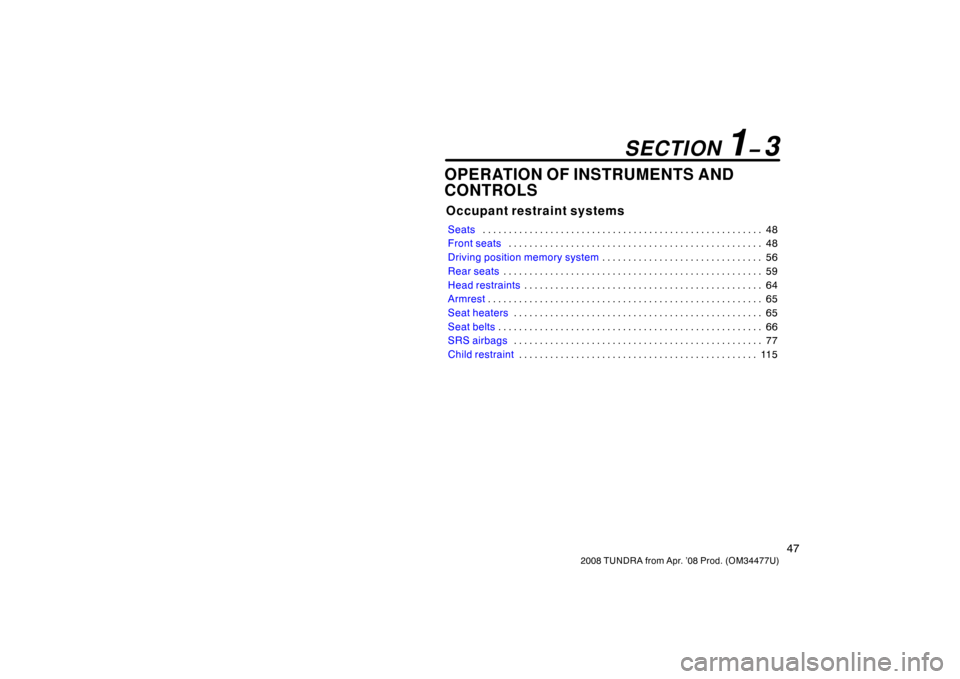
47
2008 TUNDRA from Apr. ’08 Prod. (OM 34477U)
OPERATION OF INSTRUMENTS AND
CONTROLS
Occupant restraint systems
Seats 48
. . . . . . . . . . . . . . . . . . . . . . . . . . . . . . . . . . . . .\
. . . . . . . . . . . . . . . . .
Front seats 48
. . . . . . . . . . . . . . . . . . . . . . . . . . . . . . . . . . . . \
. . . . . . . . . . . . .
Driving position memory system 56
. . . . . . . . . . . . . . . . . . . . . . . . . . . . . . .
Rear seats 59
. . . . . . . . . . . . . . . . . . . . . . . . . . . . . . . . . . . . \
. . . . . . . . . . . . . .
Head restraints 64
. . . . . . . . . . . . . . . . . . . . . . . . . . . . . . . . . . . . \
. . . . . . . . . .
Armrest 65
. . . . . . . . . . . . . . . . . . . . . . . . . . . . . . . . . . . . \
. . . . . . . . . . . . . . . . .
Seat heaters 65
. . . . . . . . . . . . . . . . . . . . . . . . . . . . . . . . . . . . \
. . . . . . . . . . . .
Seat belts 66
. . . . . . . . . . . . . . . . . . . . . . . . . . . . . . . . . . . . \
. . . . . . . . . . . . . . .
SRS airbags 77
. . . . . . . . . . . . . . . . . . . . . . . . . . . . . . . . . . . . \
. . . . . . . . . . . .
Child restraint 11 5
. . . . . . . . . . . . . . . . . . . . . . . . . . . . . . . . . . . . \
. . . . . . . . . .
SECTION 1� 3
Page 58 of 621
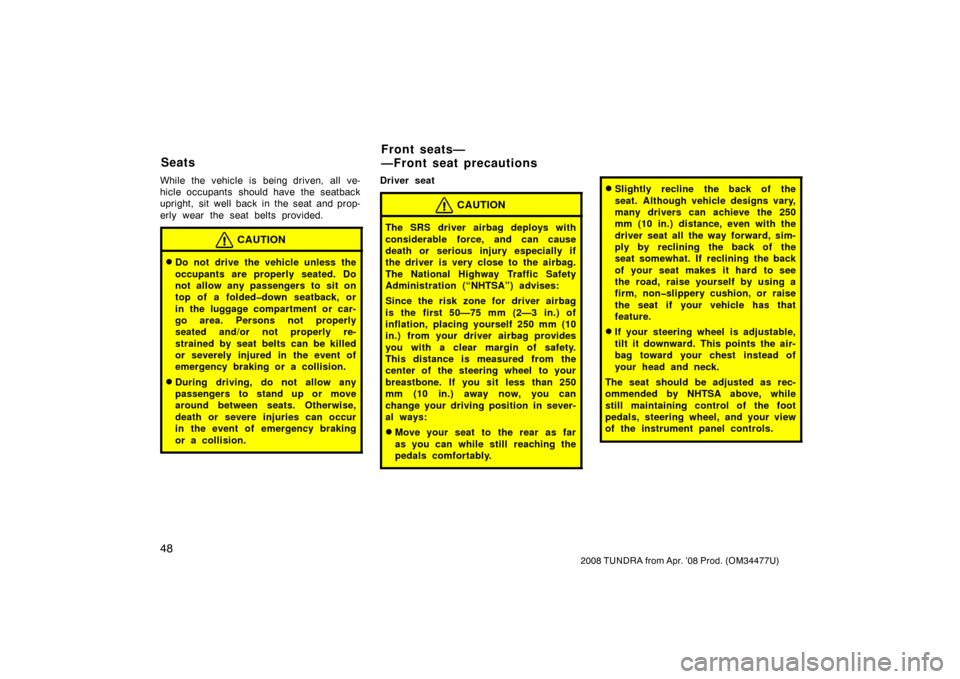
48
2008 TUNDRA from Apr. ’08 Prod. (OM 34477U)
While the vehicle is being driven, all ve-
hicle occupants should have the seatback
upright, sit well back in the seat and prop-
erly wear the seat belts provided.
CAUTION
�Do not drive the vehicle unless the
occupants are properly seated. Do
not allow any passengers to sit on
top of a folded�down seatback, or
in the luggage compartment or car-
go area. Persons not properly
seated and/or not properly re-
strained by seat belts can be killed
or severely injured in the event of
emergency braking or a collision.
�During driving, do not allow any
passengers to stand up or move
around between seats. Otherwise,
death or severe injuries can occur
in the event of emergency braking
or a collision.
Driver seat
CAUTION
The SRS driver airbag deploys with
considerable force, and can cause
death or serious injury especially if
the driver is very close to the airbag.
The National Highway Traffic Safety
Administration (“NHTSA”) advises:
Since the risk zone for driver airbag
is the first 50—75 mm (2—3 in.) of
inflation, placing yourself 250 mm (10
in.) from your driver airbag provides
you with a clear margin of safety.
This distance is measured from the
center of the steering wheel to your
breastbone. If you sit less than 250
mm (10 in.) away now, you can
change your driving position in sever-
al ways:
�Move your seat to the rear as far
as you can while still reaching the
pedals comfortably.
�Slightly recline the back of the
seat. Although vehicle designs vary,
many drivers can achieve the 250
mm (10 in.) distance, even with the
driver seat all the way forward, sim-
ply by reclining the back of the
seat somewhat. If reclining the back
of your seat makes it hard to see
the road, raise yourself by using a
firm, non�slippery cushion, or raise
the seat if your vehicle has that
feature.
�If your steering wheel is adjustable,
tilt it downward. This points the air-
bag toward your chest instead of
your head and neck.
The seat should be adjusted as rec-
ommended by NHTSA above, while
still maintaining control of the foot
pedals, steering wheel, and your view
of the instrument panel controls.
Seats Front seats—
—Front seat precautions
Page 61 of 621
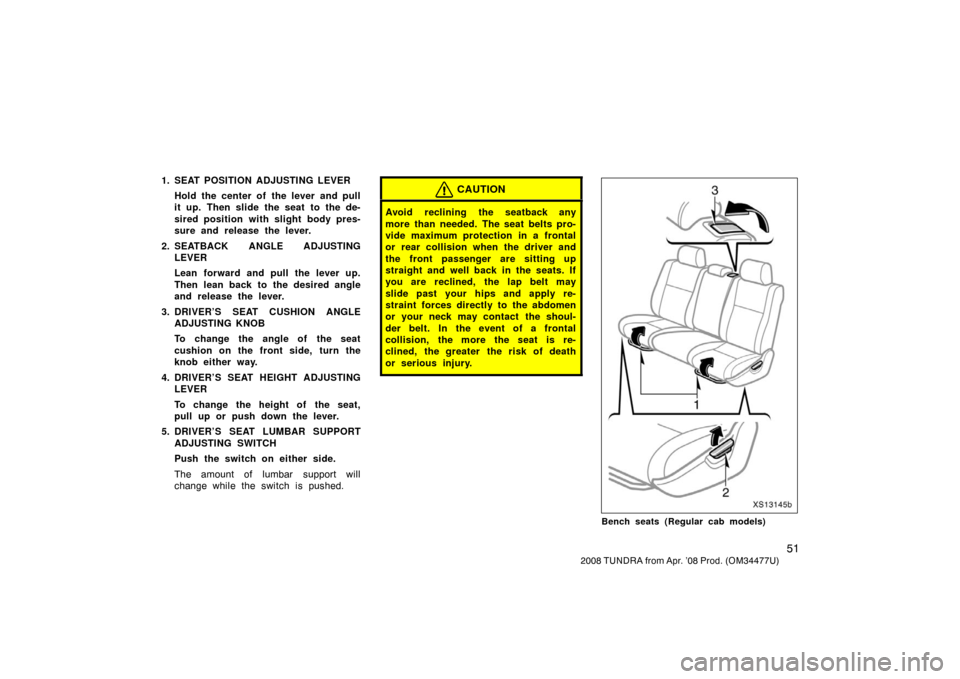
51
2008 TUNDRA from Apr. ’08 Prod. (OM 34477U)
1. SEAT POSITION ADJUSTING LEVER
Hold the center of the lever and pull
it up. Then slide the seat to the de-
sired position with slight body pres-
sure and release the lever.
2. SEATBACK ANGLE ADJUSTING LEVER
Lean forward and pull the lever up.
Then lean back to the desired angle
and release the lever.
3. DRIVER’S SEAT CUSHION ANGLE ADJUSTING KNOB
To change the angle of the seat
cushion on the front side, turn the
knob either way.
4. DRIVER’S SEAT HEIGHT ADJUSTING LEVER
To change the height of the seat,
pull up or push down the lever.
5. DRIVER’S SEAT LUMBAR SUPPORT ADJUSTING SWITCH
Push the switch on either side.
The amount of lumbar support will
change while the switch is pushed.CAUTION
Avoid reclining the seatback any
more than needed. The seat belts pro-
vide maximum protection in a frontal
or rear collision when the driver and
the front passenger are sitting up
straight and well back in the seats. If
you are reclined, the lap belt may
slide past your hips and apply re-
straint forces directly to the abdomen
or your neck may contact the shoul-
der belt. In the event of a frontal
collision, the more the seat is re-
clined, the greater the risk of death
or serious injury.
XS13145b
Bench seats (Regular cab models)
Page 62 of 621
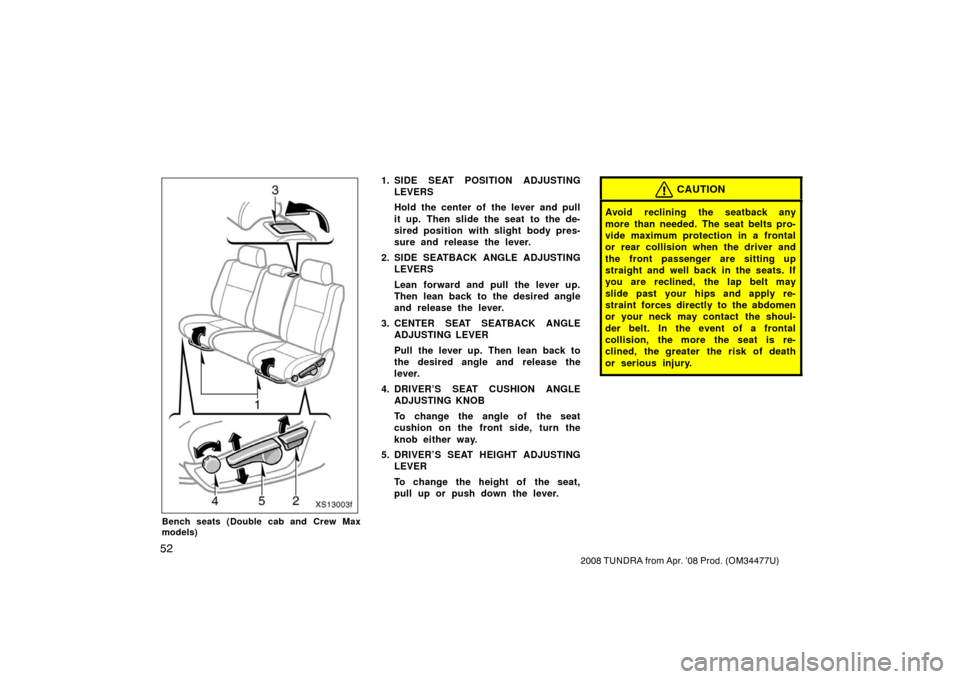
52
2008 TUNDRA from Apr. ’08 Prod. (OM 34477U)
XS13003f
Bench seats (Double cab and Crew Max
models)
1. SIDE SEAT POSITION ADJUSTING
LEVERS
Hold the center of the lever and pull
it up. Then slide the seat to the de-
sired position with slight body pres-
sure and release the lever.
2. SIDE SEATBACK ANGLE ADJUSTING LEVERS
Lean forward and pull the lever up.
Then lean back to the desired angle
and release the lever.
3. CENTER SEAT SEATBACK ANGLE ADJUSTING LEVER
Pull the lever up. Then lean back to
the desired angle and release the
lever.
4. DRIVER’S SEAT CUSHION ANGLE ADJUSTING KNOB
To change the angle of the seat
cushion on the front side, turn the
knob either way.
5. DRIVER’S SEAT HEIGHT ADJUSTING LEVER
To change the height of the seat,
pull up or push down the lever.CAUTION
Avoid reclining the seatback any
more than needed. The seat belts pro-
vide maximum protection in a frontal
or rear collision when the driver and
the front passenger are sitting up
straight and well back in the seats. If
you are reclined, the lap belt may
slide past your hips and apply re-
straint forces directly to the abdomen
or your neck may contact the shoul-
der belt. In the event of a frontal
collision, the more the seat is re-
clined, the greater the risk of death
or serious injury.
Page 64 of 621

54
2008 TUNDRA from Apr. ’08 Prod. (OM 34477U)
3. SEATBACK ANGLE ADJUSTING
SWITCH
Move the control switch in the de-
sired direction.
Releasing the switch will stop the seat-
back at that position.
CAUTION
Avoid reclining the seatback any
more than needed. The seat belts pro-
vide maximum protection in a frontal
or rear collision when the driver and
the front passenger are sitting up
straight and well back in the seats. If
you are reclined, the lap belt may
slide past your hips and apply re-
straint forces directly to the abdomen
or your neck may contact the shoul-
der belt. In the event of a frontal
collision, the more the seat is re-
clined, the greater the risk of death
or serious injury.
4. SEAT LUMBER SUPPORT ADJUSTINGSWITCH
Push the switch on either side.
The amount of lumbar support will
change while the switch is pushed.
XS13209
BEFORE FOLDING FRONT
PASSENGER’S SEAT
1. Push the seat belt hanger down as far as it will go when it is in the
raised position.
XS13160
2. Make sure the shoulder belt passesthrough the hanger when folding the
front passenger ’s seat.
This prevents the shoulder belt from being
damaged.
CAUTION
The seat belt must be removed from
the hanger when the seat belt is in
use.
—Folding front passenger ’s
seat (on some models)
Page 69 of 621
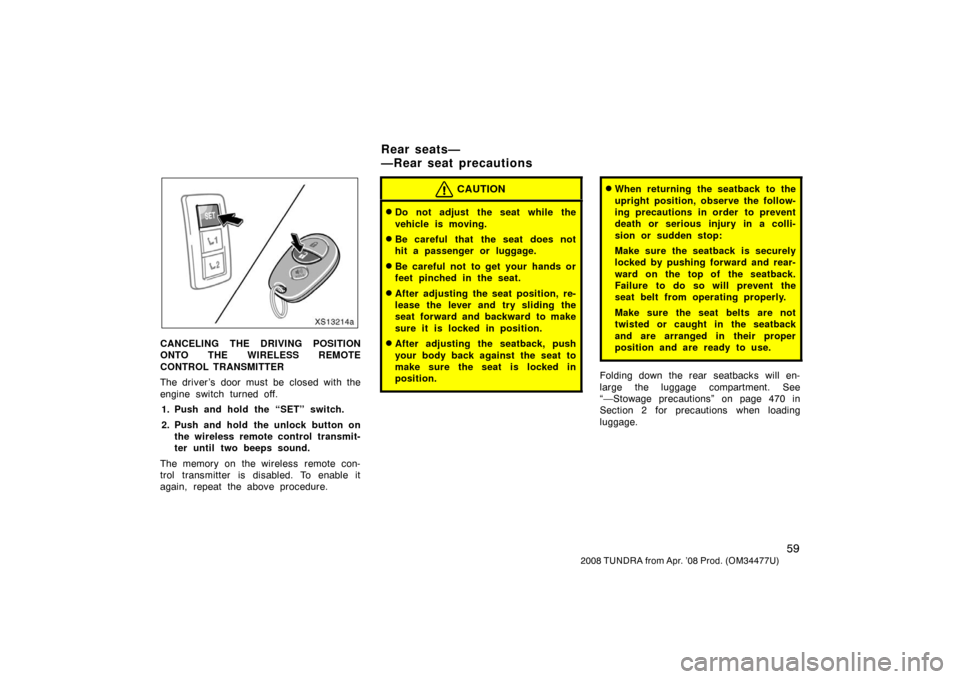
59
2008 TUNDRA from Apr. ’08 Prod. (OM 34477U)
XS13214a
CANCELING THE DRIVING POSITION
ONTO THE WIRELESS REMOTE
CONTROL TRANSMITTER
The driver’s door must be closed with the
engine switch turned off.
1. Push and hold the “SET” switch.
2. Push and hold the unlock button on the wireless remote control transmit-
ter until two beeps sound.
The memory on the wireless remote con-
trol transmitter is disabled. To enable it
again, repeat the above procedure.
CAUTION
�Do not adjust the seat while the
vehicle is moving.
�Be careful that the seat does not
hit a passenger or luggage.
�Be careful not to get your hands or
feet pinched in the seat.
�After adjusting the seat position, re-
lease the lever and try sliding the
seat forward and backward to make
sure it is locked in position.
�After adjusting the seatback, push
your body back against the seat to
make sure the seat is locked in
position.
�When returning the seatback to the
upright position, observe the follow-
ing precautions in order to prevent
death or serious injury in a colli-
sion or sudden stop:
Make sure the seatback is securely
locked by pushing forward and rear-
ward on the top of the seatback.
Failure to do so will prevent the
seat belt from operating properly.
Make sure the seat belts are not
twisted or caught in the seatback
and are arranged in their proper
position and are ready to use.
Folding down the rear seatbacks will en-
large the luggage compartment. See
“—Stowage precautions” on page 470 in
Section 2 for precautions when loading
luggage.
Rear seats—
—Rear seat precautions